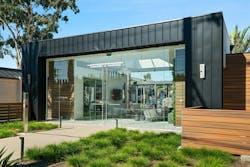The benefits of strategic multifamily housing repositioning
In the face of the nation’s housing crisis, there has been a lot of talk about ground-up multifamily construction—and with good reason. The only way to solve the housing crisis is to add more housing.
With the rapid increase in new developments, owners of existing assets face increasing competition. As their assets age and the number of new developments increases seemingly day-by-day, developers will inevitably have to find a way to stay relevant.
In many cases, their best option is to reposition. Repositioning can allow owners of existing assets to keep up in the amenities arms race while saving money and reducing environmental impact versus razing their existing asset and building a new one from scratch.
Multifamily Amenities Arms Race
With the recent surge in multifamily competition, developers are constantly searching for ways to differentiate their communities to potential renters who are being lured by amenities and the promise of an extravagant lifestyle. These renters have come to desire and expect more than just a place to live. They want a resort-like environment with all of the conveniences that entails. This has kicked off an amenities arms race.
Multifamily developers have been outdoing themselves, adding evermore extraordinary amenities like fitness centers that blur the exterior and interior outfitted with all the latest fitness technology; work from home spaces; parcel pending lockers; dog parks and pet wash facilities; as well as roof terraces for hosting community events like movie nights and happy hours—all in an effort to promise residents the most exciting lifestyle.
For owners of existing assets that may only have a pool and a sparsely equipped fitness center, or no amenities at all, repositioning could be the key to staying relevant. For instance, at our most recently completed renovation project Vercanta in Newport Beach, Calif., we added a 1,400 SF “proscenium” building to increase curb appeal and serve as a leasing office with mail and package facilities, a new 2,500-sf airy and light-filled fitness center with state-of-the-art equipment, completely updated the landscape and hardscape as well as added a brand-new pool, pool deck, barbecue area and dog park.
In addition to full unit renovations, these new amenities took Vercanta from being one of the worst performing to one of the best performing multifamily communities in the area. The right amenities can make all the difference in a multifamily development’s competitiveness.
Economics
In addition to increasing an existing development’s competitiveness in the marketplace, repositioning can offer economic incentives and an increased ROI versus new construction. According to Spruce, an average build or rebuild can cost as much as 20% more than an existing structure. These cost savings can come from many areas. As the saying goes, “the most expensive parts of a building are the parts you don’t see,” such as the mechanical, electrical, and plumbing systems. In many cases these parts of the building can be reused. Even when they can’t be reused, these systems can be replaced with modern, more efficient systems that can contribute savings in the long run.
Additionally repositioning creates an opportunity for densification and increased unit count. Current regulations allow multifamily developers to create Accessory Dwelling Units on their property during renovations and supplement their unit counts up to 25%. This not only augments the bottom line for these communities, but can also be a small, but not inconsequential, contribution to decreasing the housing shortage.
Environmental
Lastly, the environmental benefits of repositioning an existing multifamily community cannot be ignored. The process of razing a building to construct a new one tends to have a greater environmental impact than repositioning. New construction is much more material intensive and creates more waste in addition to the waste from the demolition compared to strategically gutting only the parts that need to be upgraded.
New materials aren’t only costly. They also require extraction, packaging, and transportation which adds to the projects emissions while also causing more air, water, and noise pollution.
Beyond the construction process, repositioning provides the opportunity to upgrade from old, possibly obsolete, systems to new greener technology. This can lead to a diminished environmental impact for the community for years, possibly even decades, to come.
For multifamily community owners weathering a deluge of new competition, repositioning offers a way to keep up in the amenities arms race as well as economic incentives like densification opportunities and increased ROI—all while limiting the environmental impact of the construction process in comparison to ground-up development. For all of these reasons, these owners should consider strategic repositioning a very attractive option.
